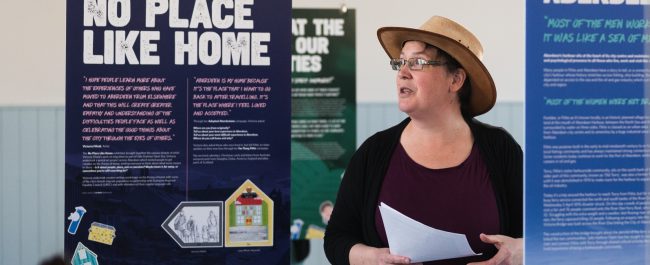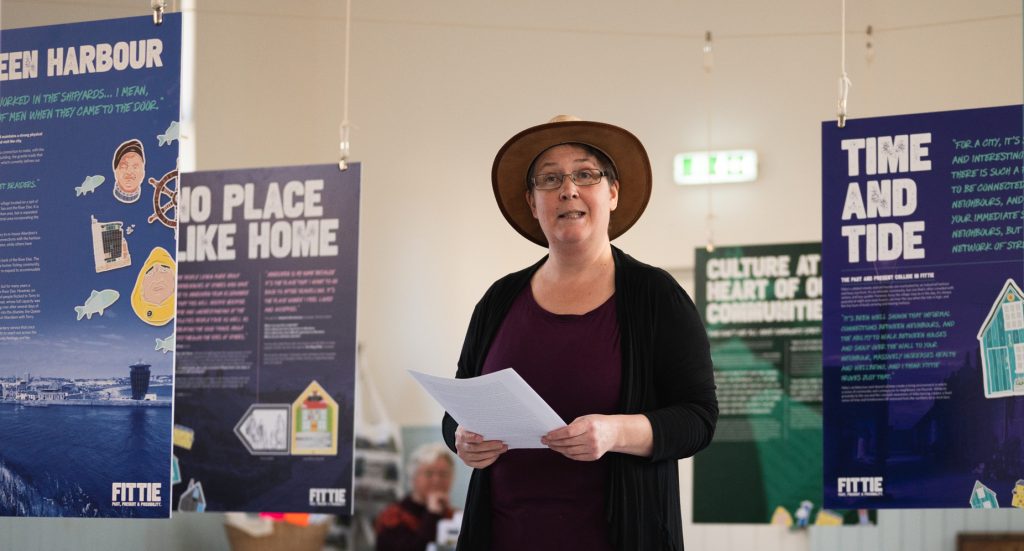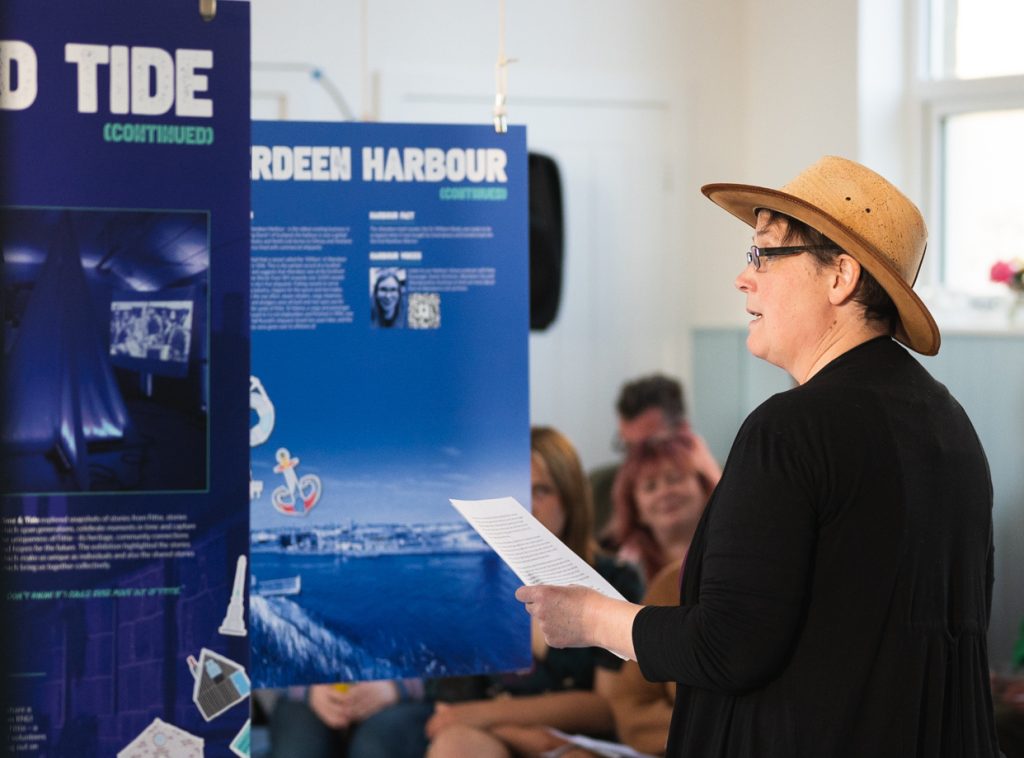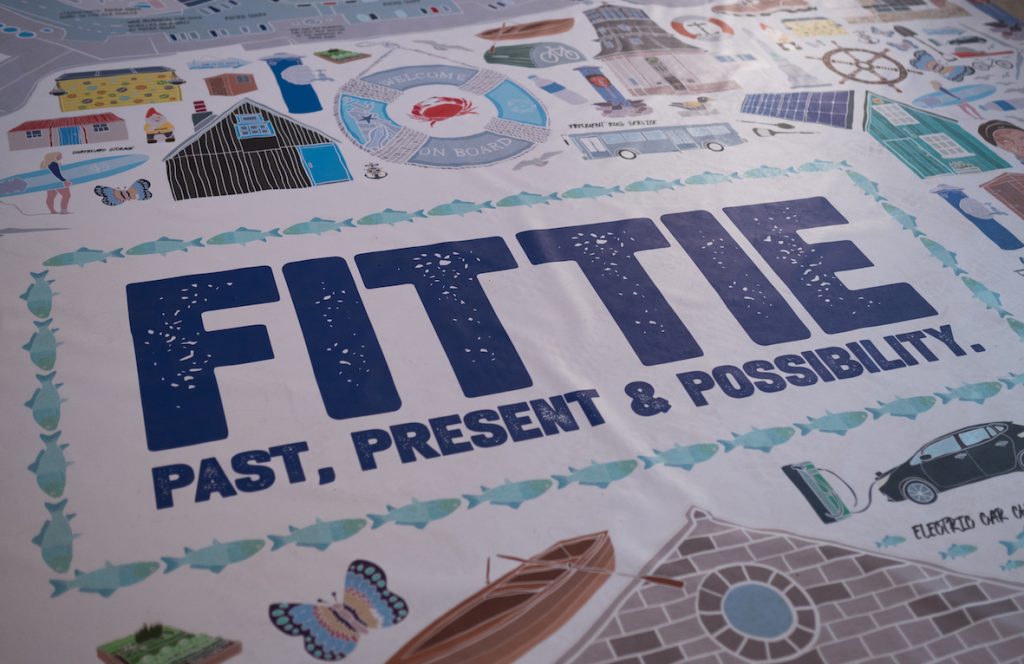Fittie – Past, Present, and Future – a Story
As part of her residency in Fittie environmental storyteller Cara Silversmith of One Nature Education crafted a story for the community, based on her time in Fittie, the stories residents shared with her and her environmental knowledge and passions.
This land where we stand at the foot of the River Dee, Footdee – Fittie – has strands of stories that wind their way inland to the mountains and out on cresting waves beyond rising tides, to the grey horizon. Yours is one of those captivating tales that holds community together. But how do you follow one fine silver thread of a story when you are distracted by so much silver in the sea? Herring. Salmon. Whale. Glistening Oil. All have stories here.
I cannot tell all those tales, so I will pick up one story thread and see where it takes us. This thread is one that starts at the beginning with the land herself.
Once upon a time, long, long ago, this land was at the bottom of a shallow tropical sea before the waters retreated and a lush forest bloomed. The tectonic plates shifted and a desert formed before being compressed and folded. Turned to granite and gabbro. Enormous mountains grew to the west. Great dinosaurs ranged through lush, monstrous vegetation. Carbon rich rocks, giants! were laid down, locking in over 50 million years of the sun’s energy which beat down on sub-tropical land from the wide arc of the sky.
Over time this land fluxed up and down, with the breath of the earth itself, drifting northwards all the while. Great ice sheets covered, then retreated over the mountains, grinding them down and casting the loose rock and tillings far out to sea. Covering the sleeping giants of the past in a mineral blanket.
Just 6,000 years ago the sea covered this nub of land on which we stand, before the Sea Mither called the waves back to play further out. The land, freed from the rolling waves and basking in sunlight blossomed with her new role. A home. A place to nurture those who would rest here. Land that gave life to a community.
Were there surfers and wild swimmers here then? Did they stare out to sea wondering about a future that was so unimaginable?
This then is a story of change, so let us close the net in on more recent times. The land remembers the echoes of all who have walked this way, who have made their lives here in this special place.
Children laugh down on the beach. Turning over stones and squealing at the crabs. The golden sand, soft underfoot, as they tread the grains of ancient mountains. Splashing in the sun-starred water here before continuing its endless procession around the world. Tides have always held sway here.
Small silver fish run in and out of the shallows avoiding little feet. Someone else picks up a stick and begins to draw. Writing in the sand. Sacks are dragged along by the bigger children. Collecting driftwood, gathering up the larger pieces between them to take up to the houses. And such houses they were. Two squares. Facing inward. Offering a place of retreat and comfort for 28 houses – single storied and thatched.
In the early days of these buildings, Leviathans of the deep were processed here. Four boilers in North Square and three in South. Carved up pieces of whale were fed into the 10 tonne boilers and simmered for three hours before being transferred to cooling tanks. Then on to the casks, which would be sent around the country for lighting lamps and oiling the wheels of industry, and of course lighting the Cruisie lamps to welcome the boats home.
The land was wary of that, surely the Sea Mither would be cross that her progeny were being sacrificed so, but hadn’t there always been gifts from the sea given and taken freely? The work, and associated smell carried on the air all around the harbour on every day, except the Sabbath, which was held holy. And perhaps that was enough reflected the land. Honouring the gifts of the earth has always guaranteed her inhabitants a future. The whale bone arches facing out to sea were a symbol of pride and of gratitude. Soon though the Sea Mither withdrew those gifts and the boilers stayed empty.
But the silver darlings were still brought to shore. Silver darlings – bright mercury fast fish. Their name – herring – comes from the old Germanic word meaning multitude. And they were here in multitudes, along with the salmon who swam up the river in such numbers that the rumour was you could walk across the waters on their backs. Herring slide out of the crates and are gutted packed and sent to markets in Edinburgh, York, London and beyond. The herring trade, the oldest fishing industry in the country. One of the first to bloom after Christianity overturned the taboo on people taking fish, our most ancient of ancestors, from the sea.
Lassies could make a good living travelling up and down the country, following the shoals. Not that Fittie folk would do that. Grounded that is what a place like this meant. You were of the square, of the land, between tide and port. North or South, Middle Row and Pilot having been now added too. Solid and secure against the dancing waves. But those waves always threaten to overtop.
The boats that were lost, the lives the Sea Mither took back as payment. The boots by the fire waiting for the shout, when all hands would race to the coastguard station ready to face the maelstrom and rescue those they could, and do their best for those they could not.
Women rule the roost here. It is a matriarchal community. Watchful mothers, keeping an eye on the youngsters, organising priorities for pay packets and working, always working. Everyone has their role. A net on the land does not catch fish. So, there are jobs to do, making and mending. Fishing nets, hanging on the back of the door.
Gauge – block – shuttle.
Hands hardened and ready for work, are dexterous and detailed.
Needles – mending twine – shears at the ready.
Sheet-bend knots – loop the twine through, under, bend and catch.
Repeated over and over. Pots on the fire. Gossip in the air. Babies on the way. Babies wrapped up warm. Toddlers in the square. Children play and chase, before heading to the Tower of Babel for lessons. ABCs, counting and times tables, and dreaming far off shores. The teenagers down at the docks – landing and learning, fighting and devoted. Family bonds are strong and sure. They have to be. The boats and their crews rely on them, so fishermen marry the lassies they’ve known since childhood to take care of them and theirs.
Sunday, glorious Sunday was the day of rest. For faith, and worship, family and food. A day to regather and breathe after the bustle of the week. Fishing boats were tied up, everyone home safe for another day. Safe…
Safe from the sea and her dual nature – gift giver and life taker. Safe on solid land once more even though your legs sway and sea legs struggle to walk straight. Those who succumb to alcoholic libations swaying more than others. Preaching warns against the demon drink and the dangerous of straying from the routine of doctrine.
But whose doctrine? Which is the right way to be? Schisms form in the fabric of community, three days of rapture, and change rolls in as it always does. Stay firm or get washed away! Stay flexible or snap?
Mondays, always on a Monday the washing would be done. Driftwood gathered from the beach was used to heat the waters in the boiler houses for the wash day bustle. Every scrap that could be washed, scrubbed, rinsed and hung out to dry. Better hope for sun!
Sun, glittering on the water and the smoke of clipper ships in the air. Sail giving way to steam, coal and smoke. No longer the vagaries of the weather keeping boats home bound for want of wind or wrong direction. Strength enough to pull away through roughening waves. That would before have keep the sailors home. Limits being pushed. Limits pushing back…
The years dance in and out with the tides of changes piling up. World events and revolutions have their impacts here, no matter how sheltered the village feels. The busy harbour reacts to the changes, just as the residents do. This is not some place preserved in aspic, but a vibrant beating heart at the edge of city and sea. The community spirt is strong and Fittie has always been a good place to grow up. Children jumping off the pier and hopping on boats to go around the harbour. Learning their trades like their parents before them, adapting to change as it comes.
A new gift from the sea. Oil is found. A gift freely given or something to be held down? Extracted with drills and pipes. Isn’t it all the same? Where do the limits lie? Does it matter if there is money to be made?
Perhaps it matters to the Sea Mither and the land, for now there are ghosts in the sea. The ghosts of the giants who used to sleep, kept safe by their blanket of rock. For a community rooted on the shore, living with the tides, these things matter. The nets the women worked on, and the fishermen used to haul in their catches were made out of cotton, hemp, or flax. They wore with use, as all organic materials do, then the women would fix them. Giving jobs to the growers, harvesters, manufacturers, fishermen and women; and ultimately when they were lost at sea the Sea Mither would reclaim the gifts from the land and the fibres would become food for the creatures of the deep.
For the past 60 years the nets have been made of oil transformed into nylon or monofilament. Plastics that do not break down. When they are lost at sea they catch up and drown everything in their path. Then become food as the old gifts did, but now toxins build up in the food chain.
Plasticosis, a newly defined disease in sea birds, affects the rafts of birds buffed by the increasingly severe storms.
No longer do flax and hemp growers in the economy benefit. The nets need less repair, so women do not fix them, besides buying new ones is cheaper, unless you ask the sea.
Incomers wash in, the old Fittie folk move out. The money made from oil expanding their horizons. “People are getting above their station” and the old ways are changing. “Fae di they think they are?” Where is the certainty on which the community used to rely? Fittie has also caught the eye of tourists, day trippers who want to come and visit somewhere ‘quaint’. It’s an Instagramable delight. Airbnb’s and holidays homes abound, with their transient guests, incapable of sustaining the day-to-day connections that make the threads that hold a community strong.
But change is certain and can be welcomed. The incomers look out for the old women. Old buildings are renovated and new life breathed into the heart of place. The fabric of community is renewed with ceilidhs, clubs and film nights. Voices are raised in praise of place and life. Shared histories and visions of the future. Gardens bloom and the soil sighs contentedly. Environmental consciousness grows, as it needs to, and the land is glad. The storms that rock the world, and this little corner of it, are intensifying. H5N1 shows no mercy to the birds who ride the waves here. The seas are rising and the winds strengthening. So far, we have only had a taste of the power of the Sea Mither and her kin – gift giver and life taker.
Innovation transforms the coal sheds, becoming studios and healing spaces. New businesses spring into life and a plane born on this land flies overhead its registration mark proudly declaring its origins. Old stories are collected so they will not fade. Change is rolling in again, the oil industry and the economy that relies on it is becoming more volatile. New technologies are coming on stream. There are so many possibilities here. The power of the waves and sun could be gifts to explore. All it takes is an open mind and a relationship to land and sea.
So Fittie and her people approach the future. There is uncertainty – the new harbour and its cruise ships. Where are the benefits and gains of the beachfront changes? The land knows her residents are steadfast and resilient. There is so much brilliance here. Artists and teachers. Engineers and planners. Musicians and dreamers. Fishers, surfers and wild swimmers. The stories and choices to be made here connect to the far horizon of time.
Fittie, a Safe Harbour from which to face the shining Open Sea of the future.
Cara Silversmith
Cara is a storyteller, educator, and writer. She specialises in exploring stories of our environment, identity, and well-being. Cara originally worked in nature conservation, developing and delivering environmental education for regional and national parks. Her MSc thesis, in Outdoor, Environmental and Sustainability Education focused on values and personal narratives in relation to our environment. Cara was previously Eco-Schools Assessment Officer for NE Scotland giving advice to schools on Learning for Sustainability and community engagement. In 2012-13 Cara sat on the working group setting up Learning for Sustainability Scotland. She is a GTCS registered geography teacher with experience of different roles within schools. Cara is passionate about social justice issues and promoting inclusion and diversity. She is a member of the Scottish Storytelling Forum, and is currently researching and developing storytelling for the environment and better world. www.onenatureeducation.com




